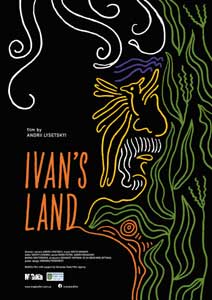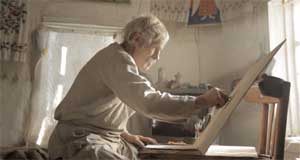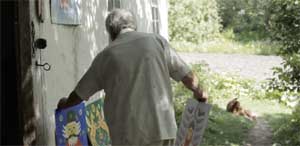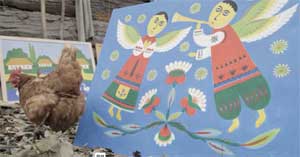

Issue 81 (2023): Focus on Contemporary Ukrainian Documentary |
Andrii Lysetskyi: Ivan’s Land (Земля Івана, 2021) reviewed by Lora Maslenitsyna © 2023 |
 Before we understand what we are seeing, we hear him and his music. Falling snowflakes slowly become legible in the darkness of night. A creature—part man, part mythic animal—emerges from the flurry, trilling rhythmically and beating a tambourine. This is Ivan Prykhodko, a Ukrainian folk artist and the subject of the documentary, Ivan’s Land.
Before we understand what we are seeing, we hear him and his music. Falling snowflakes slowly become legible in the darkness of night. A creature—part man, part mythic animal—emerges from the flurry, trilling rhythmically and beating a tambourine. This is Ivan Prykhodko, a Ukrainian folk artist and the subject of the documentary, Ivan’s Land.
 The film mainly takes place on Prykhodko’s humble homestead, where he tends to a small farm and a few animals who share it with him. Prykhodko is a cheerful figure who spends his days painting inside his home that doubles as his studio and performing enigmatic rituals and songs as the seasons evolve. The film progresses in tune with the changing environment, so as the snow thaws and spring releases blossoms, Prykhodko ventures into town to sell his hand-carved toys and sculptures, promote his artworks to galleries, and teach art lessons to schoolchildren. Once in a while, visitors call upon Prykhodko at his home and he generously shares his paintings and a meal with them. In the end, the film juxtaposes images of Prykhodko in costume with the faces of the people in the city who come to see his paintings displayed in the gallery. This succession of images captures their immediate sense of rapture, but with the changing of the seasons, it ambivalently questions whether the exhibition is enough to foster a thriving folk art tradition in contemporary Ukraine.
The film mainly takes place on Prykhodko’s humble homestead, where he tends to a small farm and a few animals who share it with him. Prykhodko is a cheerful figure who spends his days painting inside his home that doubles as his studio and performing enigmatic rituals and songs as the seasons evolve. The film progresses in tune with the changing environment, so as the snow thaws and spring releases blossoms, Prykhodko ventures into town to sell his hand-carved toys and sculptures, promote his artworks to galleries, and teach art lessons to schoolchildren. Once in a while, visitors call upon Prykhodko at his home and he generously shares his paintings and a meal with them. In the end, the film juxtaposes images of Prykhodko in costume with the faces of the people in the city who come to see his paintings displayed in the gallery. This succession of images captures their immediate sense of rapture, but with the changing of the seasons, it ambivalently questions whether the exhibition is enough to foster a thriving folk art tradition in contemporary Ukraine.
 Ivan’s Land avoids narration or contextual information, and effaces the presence of the filmmaker. Oftentimes, the camera takes a wide-angle perspective of Prykhodko’s studio where he paints most of his works with occasional close ups of brushstrokes and Prykhodko’s furrowed brow as he ponders over the colors. The camera is a quiet presence in this film that often angles up towards Prykhodko from the level of his canvas. As a result, the film cultivates the sense of the viewer as a friendly visitor of Prykhodko’s daily life. In this idyllic setting, the viewer looks up at Ivan from the immersed perspective of his motley family of pets. As Prykhodko feeds his dogs, gently scolds his unruly chickens, and recalls fragments of folk wisdom, so is the viewer nourished by sharing in his company.
Ivan’s Land avoids narration or contextual information, and effaces the presence of the filmmaker. Oftentimes, the camera takes a wide-angle perspective of Prykhodko’s studio where he paints most of his works with occasional close ups of brushstrokes and Prykhodko’s furrowed brow as he ponders over the colors. The camera is a quiet presence in this film that often angles up towards Prykhodko from the level of his canvas. As a result, the film cultivates the sense of the viewer as a friendly visitor of Prykhodko’s daily life. In this idyllic setting, the viewer looks up at Ivan from the immersed perspective of his motley family of pets. As Prykhodko feeds his dogs, gently scolds his unruly chickens, and recalls fragments of folk wisdom, so is the viewer nourished by sharing in his company.
 While it is not uncommon for nonfiction films to make use of natural light over cumbersome artificial sources, Lysetskyi sculpts sunlight to illuminate the nuances of Prykhodko’s craftsmanship. Lysetskyi often captures Prykhodko at work from a low angle tilted up towards the artist. The sunlight that filters in through the only window spotlights him, creating a unique portrait in every frame and directing the viewer’s attention on his face as if by the stroke of an Old Master. Importantly, the natural light invites the viewer to see Prykhodko’s paintings as closely as possible to the way he intends for them to be seen. Prykhodko has a tentative relationship to showing his paintings in galleries, as shown at the end of the film when he seems to peer anxiously at the enormous hall that will display his works. He prefers for the vibrant yellows, reds, and greens on the canvases to draw viewers into their natural surroundings. Lysetskyi’s use of sunlight also allows the director to overtly describe the film’s progression of time and changing seasons. We are only able to catch a glimpse of Prykhodko’s artistic process—a personal narration of his every move and choice of color on the canvas—once the sun rises. Once the sun sets, Lysetskyi emphasizes the enigmatic nature of Prykhodko’s performances through the only artificial light used throughout the film: fire.
While it is not uncommon for nonfiction films to make use of natural light over cumbersome artificial sources, Lysetskyi sculpts sunlight to illuminate the nuances of Prykhodko’s craftsmanship. Lysetskyi often captures Prykhodko at work from a low angle tilted up towards the artist. The sunlight that filters in through the only window spotlights him, creating a unique portrait in every frame and directing the viewer’s attention on his face as if by the stroke of an Old Master. Importantly, the natural light invites the viewer to see Prykhodko’s paintings as closely as possible to the way he intends for them to be seen. Prykhodko has a tentative relationship to showing his paintings in galleries, as shown at the end of the film when he seems to peer anxiously at the enormous hall that will display his works. He prefers for the vibrant yellows, reds, and greens on the canvases to draw viewers into their natural surroundings. Lysetskyi’s use of sunlight also allows the director to overtly describe the film’s progression of time and changing seasons. We are only able to catch a glimpse of Prykhodko’s artistic process—a personal narration of his every move and choice of color on the canvas—once the sun rises. Once the sun sets, Lysetskyi emphasizes the enigmatic nature of Prykhodko’s performances through the only artificial light used throughout the film: fire.
 The film’s narrative emerges through recurring shots of the landscape surrounding Prykhodko’s home. These shots act as headings to a series of vignettes about Prykhodko’s habits and creative process woven through the changing seasons. As the film cultivates the sense of time passing, it leads the viewer to the understanding that Prykhodko’s art grows together in a harmonic relationship to his environment. Dividing Prykhodko’s works from the land on which he creates them would violently cleave the paintings from a vital source of their power. As the seasons change, Prykhodko takes care to harvest and replant his crops, but he also begins to notice an increasing presence of planes flying overhead. These mechanical birds disrupt the diegetic sound of the forest and serve as a reminder of the modernized lifestyle of the distant city and the forced migration of people in Ukraine.
The film’s narrative emerges through recurring shots of the landscape surrounding Prykhodko’s home. These shots act as headings to a series of vignettes about Prykhodko’s habits and creative process woven through the changing seasons. As the film cultivates the sense of time passing, it leads the viewer to the understanding that Prykhodko’s art grows together in a harmonic relationship to his environment. Dividing Prykhodko’s works from the land on which he creates them would violently cleave the paintings from a vital source of their power. As the seasons change, Prykhodko takes care to harvest and replant his crops, but he also begins to notice an increasing presence of planes flying overhead. These mechanical birds disrupt the diegetic sound of the forest and serve as a reminder of the modernized lifestyle of the distant city and the forced migration of people in Ukraine.
 Prykhodko’s representations of Ukrainian folk traditions maintain a political stance. In one scene, people interested in purchasing Ivan’s artworks arrive at his farm. He shows them a few pictures, one of which they identify as an image of Grandfather Frost. Ivan quickly corrects them by interjecting, “Let’s leave Saint Nicholas for Putin.” Using local dialects and the Ukrainian language act as methods of resistance against the Kremlin’s propaganda. As Prykhodko asserts, “My art is a protest against the extermination of Ukrainian culture.”
Prykhodko’s representations of Ukrainian folk traditions maintain a political stance. In one scene, people interested in purchasing Ivan’s artworks arrive at his farm. He shows them a few pictures, one of which they identify as an image of Grandfather Frost. Ivan quickly corrects them by interjecting, “Let’s leave Saint Nicholas for Putin.” Using local dialects and the Ukrainian language act as methods of resistance against the Kremlin’s propaganda. As Prykhodko asserts, “My art is a protest against the extermination of Ukrainian culture.”
 Ivan’s Land arrives at a poignant moment for the preservation of Ukrainian folk art and history. In the first few days of Russia’s invasion of Ukraine in February 2022, Russian forces deliberately burned down the Ivankiv Historical and Local History Museum. The attack resulted in the destruction of works by folk artists Maria Prymachenko and Hanna Veres. A local man managed to save some of the works by running into the burning building, emblematically proving the vital status of folk art to the survival and longevity of a people. Prykhodko’s works are testament to folk art as a fundamental medium of survival against the Putin regime’s campaign to exterminate the traditions, culture, and material traces of the Ukrainian people. Prykhodko’s determination to keep Ukrainian folk art alive, as well as Lysetskyi’s immersive documentation of this practice, actively oppose and combat this erasure.
Ivan’s Land arrives at a poignant moment for the preservation of Ukrainian folk art and history. In the first few days of Russia’s invasion of Ukraine in February 2022, Russian forces deliberately burned down the Ivankiv Historical and Local History Museum. The attack resulted in the destruction of works by folk artists Maria Prymachenko and Hanna Veres. A local man managed to save some of the works by running into the burning building, emblematically proving the vital status of folk art to the survival and longevity of a people. Prykhodko’s works are testament to folk art as a fundamental medium of survival against the Putin regime’s campaign to exterminate the traditions, culture, and material traces of the Ukrainian people. Prykhodko’s determination to keep Ukrainian folk art alive, as well as Lysetskyi’s immersive documentation of this practice, actively oppose and combat this erasure.
The film begins and ends in winter, with Prykhodko collecting firewood to stay warm inside his home. This mundane task gestures to the rootedness of the film. To stay in Ukraine and to document the life of a thriving investment into Ukrainian folk culture is to refuse extinguishing its flame.
Lora Maslenitsyna
Yale University
Ivan’s Land, Ukraine, 2021
Color, 85 min.
Director: Andrii Lysetskyi
Sound: Boris Peter
Music: Nikita Moiseev
Producers: Gennady Kofman, Olha Beskhmelnytsina
Production: MaGiKa Film, with support by the Ukrainian State Film Agency
Andrii Lysetskyi: Ivan’s Land (Земля Івана, 2021) reviewed by Lora Maslenitsyna © 2023 |